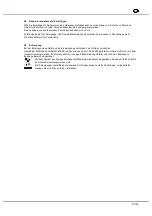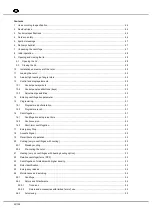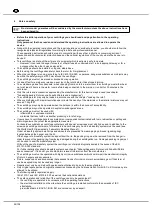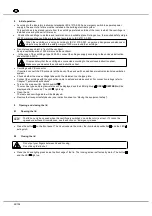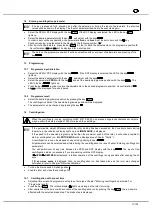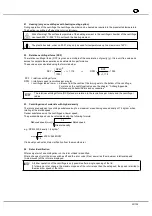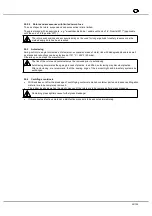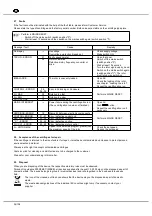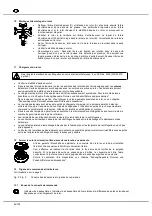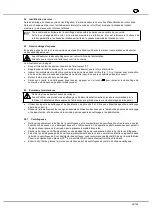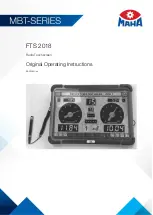
EN
34/104
25 Emergency release
During a power failure the lid cannot be unlocked by motor. An emergency release has to be executed by hand.
For emergency release disconnect the centrifuge from the mains.
Open the lid only during rotor standstill.
See figure on page 2.
x
Switch off the mains switch (switch position "0").
x
Look through the window in the lid to be sure that the rotor has come to a standstill.
x
Insert the hexagon socket head wrench horizontally into the drilling (Fig. 1, A) and carefully rotate by half a turn
in clockwise direction until the lid can be opened.
x
Pull the hexagon socket head wrench out of the drilling again.
x
After turning the centrifuge on again, press the button so that the motor-driven lid locking once again assumes
the normal position (opened).
26 Maintenance and servicing
Pull the mains plug before cleaning.
Before any other cleaning or decontamination process other than that recommended by the manufacturer is
applied, the user has to check with the manufacturer that the planned process does not damage the device.
x
Cleaning agents and disinfectants which lie in the pH range 5 – 8 are to be utilised. Alkaline cleaning agents with
a pH value > 8 are to be avoided.
x
In order to prevent appearances of corrosion through cleaning agents or disinfectants, the application guide from
the manufacturer of the cleaning agent or disinfectant are absolutely to be heeded.
26.1 Centrifuge
x
Clean the centrifuge housing and the centrifuging chamber regularly, using soap or a mild detergent and a damp
cloth if required. For one thing, this services purposes of hygiene, and it also prevents corrosion through
adhering impurities.
x
In the event of condensation water formation, dry the centrifugal chamber by wiping out with an absorbent cloth.
x
If infectious materials penetrates into the centrifugal chamber this is to be disinfected immediately. For surface
disinfection we recommend Bacillol® manufactured by Bode Chemie in Hamburg or Biocidal ZF
TM
from the
company WAK-Chemie Medical GmbH in Steinbach.
x
Lightly grease the rubber seal of the centrifugal chamber after every cleaning.
26.2 Rotors and Attachments
x
In order to prevent corrosion and material changes, rotors and accessories must be cleaned regularly with soap
or a mild detergent and a damp cloth. Cleaning is recommended at least once a week, even better after every
usage.
x
If the rotor or accessory parts are contaminated by pathogenic or radioactive material, a suitable cleaning has to
be executed. For disinfection we recommend Helipur
®
H plus N from the company B. Braun Melsungen. For the
removal of radioactive material we recommend decon neutracon
®
from the company Decon Laboratories
Limited.
x
The rotors and accessory parts must be dried immediately after cleaning.
x
Angle rotors, container and hanger made of aluminium are to be lightly greased after drying using acid-free
grease, e.g. vaseline.
x
With aerosol-sealed rotors and bio safety systems (see Chapter "Anhang/Appendix, Rotoren und
Zubehör/Rotors and accessories") the sealing rings are to be checked and cleaned regularly (weekly). The
sealing ring is to be replaced immediately upon indication of crack formation, embrittlement or abrasive wear. To
prevent the sealing ring from twisting when the lid is opened and closed, the sealing ring must be lightly greased
with acid-free grease, such as Vaseline.
x
In order to prevent corrosion as a result of moisture between the rotor and the motor shaft, the rotor should be
disassembled and cleaned at least once a month, and the motor shaft should be lightly greased.
x
The rotors and accessory parts are to be checked on a monthly basis for corrosion damage.
Rotors and attachments may no longer be utilised upon indication of wear and tear or corrosion.
x
Check the firm seating of the rotor on a weekly basis.
26.2.1 Trunnions
With swing-out rotors the trunnions must be regularly lubricated (Hettich Lubricating Grease No. 4051) in order to
ensure consistent swinging out of the hangers.


